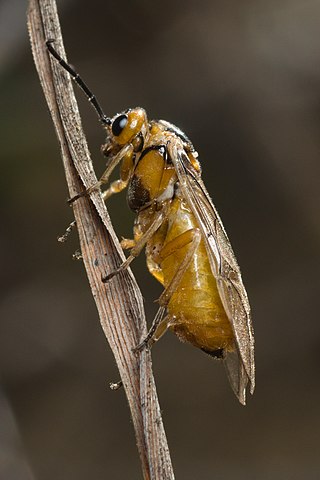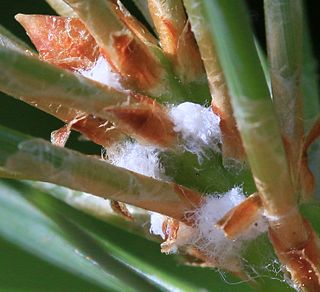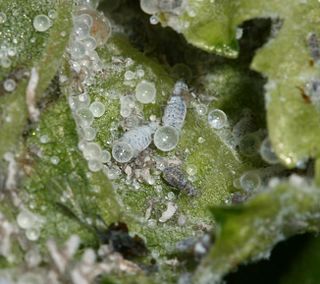
Tenthredinidae is the largest family of sawflies, with well over 7,500 species worldwide, divided into 430 genera. Larvae are herbivores and typically feed on the foliage of trees and shrubs, with occasional exceptions that are leaf miners, stem borers, or gall makers. The larvae of externally feeding species resemble small caterpillars. As with all hymenopterans, common sawflies undergo complete metamorphosis.

Andricus kollari, also known as the marble gall wasp, is a parthenogenetic species of wasp which causes the formation of marble galls on oak trees. Synonyms for the species include Cynips kollari, Andricus quercusgemmae, A. minor, A. indigenus and A. circulans.

Nematinae is a subfamily of sawflies belonging to the family Tenthredinidae. It contains over 1250 described species in ~40 genera. Members of this subfamily feed on a wide range of plants and employ a wide range of feeding habits, both internally and externally, on their host plants.

Galeopsomyia is a New World genus of hymenopteran insects of the family Eulophidae. The genus is a hyperparasitoid of other gall-inducing wasps of the genera Eurytoma and Torymus.

Andricus is a genus of oak gall wasps in the family Cynipidae.

Theodor Hartig was a German forestry biologist and botanist.

Hartigiola annulipes is a species of midge fly in the family Cecidomyiidae, found in the Palearctic. The fly was first described by Theodor Hartig in 1839. The larvae gall the leaves of beech.

Euura is a genus of sawflies of the family Tenthredinidae, subfamily Nematinae. Some of the larvae feed externally on plants and some form plant galls on willows (Salix species). In the case of the gall-forming species, when the female lays her eggs she injects a stimulant and the gall starts to form before the eggs hatch. Most sawfly galls are hard and individual larva tend to inhabit the gall, feeding on the tissue and leave the gall to pupate in the soil. Most of the species are monophages although the type species, Euura mucronata, is polyphagous feeding on over thirty species of willow.
Euura mucronata is a species of sawfly belonging to the family Tenthredinidae. The larva feed within galls on the buds of willows. It was first described by Theodor Hartig in 1837.

Scolytus rugulosus, known generally as shothole borer, is a species of typical bark beetle in the family Curculionidae. Other common names include the fruit tree bark beetle and apple tree beetle.

Pineus is a genus of aphids in the family Adelgidae. There are more than 20 described species in Pineus.

Andricus inflator is a species of gall-forming wasps, in the genus Andricus, which has a sexual and an asexual generation, producing two different galls. The wasp was named by the German biologist Theodor Hartig, in 1840 and is found in Europe.
Andricus infectorius is a species of gall-forming wasp. The species was named by the German biologist Theodor Hartig, in 1843 and is found in Europe.

Pammene argyrana is a species of moth belonging to the family Tortricidae.
Exenterus is a genus of wasps belonging to the family Ichneumonidae.
Acalitus plicans is an eriophyid mite which causes galls on beech. It is found in Europe and was first described by the Austrian zoologist Alfred Nalepa in 1917.

Eriosoma is a genus of true bugs belonging to the family Aphididae.

Mikiola is a genus of flies belonging to the family Cecidomyiidae.














